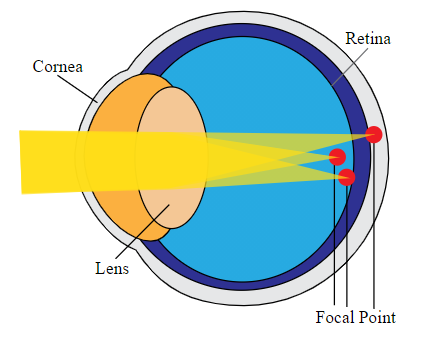Answer
392.4k+ views
Hint: For the given problem one should know the relation between the power and focal length of any lens. For any lens” power of that lens can be defined as the ability of the lens to converge a beam of light falling on the lens”.
Complete step by step answer:
Step 1:

It is given in the question that the power of cornea (let \[\mathop P\nolimits_1 \]) i.e., \[\mathop P\nolimits_1 = 40\]D and the power of eye lens (let \[\mathop P\nolimits_2 \]) i.e., \[\mathop P\nolimits_2 = 20D\].
We know that the total power of the combination of lenses is given by the below formula-
\[P = \mathop P\nolimits_1 + \mathop P\nolimits_2 \] …………...(1)
i.e., total power of any number of lenses in contact is equal to the algebraic sum of the powers of the individual lenses.
From the given conditions by keeping the values of both the powers in the equation (1), we get-
\[P = 40 + 20\]
\[P = 60D\]. …………...(2)
Step 2: As we know that power is the ability of the lens to converge the light beam falling on the lens and the is measured as the reciprocal of the focal length of the lens
i.e., \[P = \dfrac{{100}}{F}\]; where $F$ should be in cm.
But if there are a number of lenses are used then the focal length will be the equivalent focal length and it can be represented by \[\mathop F\nolimits_{equ} \]
So, \[P = \dfrac{{100}}{{\mathop F\nolimits_{equ} }}\] (3)
From equation (2) and (3) \[\mathop F\nolimits_{equ} \]can be calculated as given below-
\[\mathop F\nolimits_{equ} = \dfrac{{100}}{P}\]
\[\mathop F\nolimits_{equ} = 1.67\]cm.
$\therefore $ The distance between the retina and the cornea eye lens the distance between the retina and the cornea eye lens 1.67 cm. The correct option is (C).
Note:
(i) If the focal length is in meters then the relationship between power and focal length is given by \[P = \dfrac{1}{F}\]. So, while solving the problems it should be taken into account.
(ii) Here in this problem the focal length should be equal to the distance between the cornea and retina to see the image with clarity. If these both lengths are not equal then the image will not be clear
Complete step by step answer:
Step 1:

It is given in the question that the power of cornea (let \[\mathop P\nolimits_1 \]) i.e., \[\mathop P\nolimits_1 = 40\]D and the power of eye lens (let \[\mathop P\nolimits_2 \]) i.e., \[\mathop P\nolimits_2 = 20D\].
We know that the total power of the combination of lenses is given by the below formula-
\[P = \mathop P\nolimits_1 + \mathop P\nolimits_2 \] …………...(1)
i.e., total power of any number of lenses in contact is equal to the algebraic sum of the powers of the individual lenses.
From the given conditions by keeping the values of both the powers in the equation (1), we get-
\[P = 40 + 20\]
\[P = 60D\]. …………...(2)
Step 2: As we know that power is the ability of the lens to converge the light beam falling on the lens and the is measured as the reciprocal of the focal length of the lens
i.e., \[P = \dfrac{{100}}{F}\]; where $F$ should be in cm.
But if there are a number of lenses are used then the focal length will be the equivalent focal length and it can be represented by \[\mathop F\nolimits_{equ} \]
So, \[P = \dfrac{{100}}{{\mathop F\nolimits_{equ} }}\] (3)
From equation (2) and (3) \[\mathop F\nolimits_{equ} \]can be calculated as given below-
\[\mathop F\nolimits_{equ} = \dfrac{{100}}{P}\]
\[\mathop F\nolimits_{equ} = 1.67\]cm.
$\therefore $ The distance between the retina and the cornea eye lens the distance between the retina and the cornea eye lens 1.67 cm. The correct option is (C).
Note:
(i) If the focal length is in meters then the relationship between power and focal length is given by \[P = \dfrac{1}{F}\]. So, while solving the problems it should be taken into account.
(ii) Here in this problem the focal length should be equal to the distance between the cornea and retina to see the image with clarity. If these both lengths are not equal then the image will not be clear
Recently Updated Pages
Basicity of sulphurous acid and sulphuric acid are

Assertion The resistivity of a semiconductor increases class 13 physics CBSE

Three beakers labelled as A B and C each containing 25 mL of water were taken A small amount of NaOH anhydrous CuSO4 and NaCl were added to the beakers A B and C respectively It was observed that there was an increase in the temperature of the solutions contained in beakers A and B whereas in case of beaker C the temperature of the solution falls Which one of the following statements isarecorrect i In beakers A and B exothermic process has occurred ii In beakers A and B endothermic process has occurred iii In beaker C exothermic process has occurred iv In beaker C endothermic process has occurred

The branch of science which deals with nature and natural class 10 physics CBSE

What is the stopping potential when the metal with class 12 physics JEE_Main

The momentum of a photon is 2 times 10 16gm cmsec Its class 12 physics JEE_Main

Trending doubts
State the differences between manure and fertilize class 8 biology CBSE

Why are xylem and phloem called complex tissues aBoth class 11 biology CBSE

Difference between Prokaryotic cell and Eukaryotic class 11 biology CBSE

Difference Between Plant Cell and Animal Cell

What would happen if plasma membrane ruptures or breaks class 11 biology CBSE

Give 10 examples for herbs , shrubs , climbers , creepers

What precautions do you take while observing the nucleus class 11 biology CBSE

What would happen to the life of a cell if there was class 11 biology CBSE

Change the following sentences into negative and interrogative class 10 english CBSE



